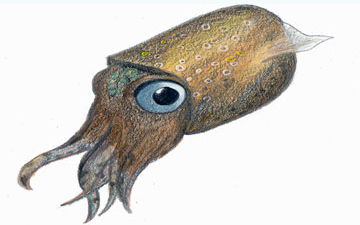The Hawaiian Bobtail Squid (Euprymna scolopes) is a species of bobtail squid native to the central Pacific Ocean, where it occurs in shallow coastal waters off the Hawaiian Islands and Midway Island.[1][2] The type specimen was collected off the Hawaiian Islands and is deposited at the National Museum of Natural History in Washington, D.C..[3]
E. scolopes grows to 30 mm in mantle length.[1] Hatchlings weigh 0.005 g and mature in 80 days. Adults weigh up to 2.67 g.[4]
In the wild, E. scolopes is known to feed on various species of shrimp, including Halocaridina rubra, Palaemon debilis, and Palaemon pacificus.[5] In the laboratory, E. scolopes has been successfully reared on a varied diet of animals, including mysids (Anisomysis sp.), brine shrimp (Artemia salina), mosquitofish (Gambusia affinis), prawns (Leander debilis), and octopuses (Octopus cyanea).[6]
E. scolopes is known to be preyed upon by the Hawaiian Monk Seal (Monachus schauinslandi) in northwestern Hawaiian waters.[7]
E. scolopes lives in a symbiotic relationship with the bioluminescent bacteria Vibrio fischeri, which inhabits a special light organ in the squid’s mantle. The bacteria are fed a sugar and amino acid solution by the squid and in return hide the squid’s silhouette when viewed from below by matching the amount of light hitting the top of the mantle.[8] E. scolopes serves as a model organism for animal-bacterial symbiosis and its relationship with V. fischeri has been the subject of much research.[9][10][11][12][13][14][15][16]
(From Wikipedia, May 4, 2010)
– – –




